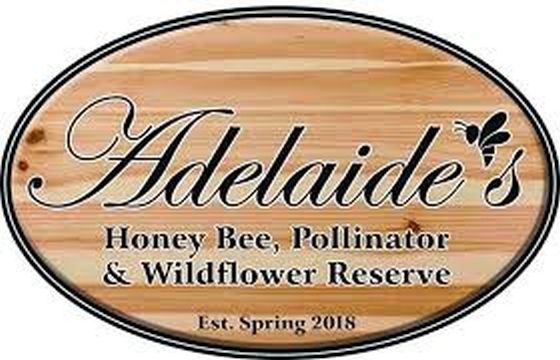By: Alan Harman
Newfoundland and Labador’s first honey bee reserve opens June 1.
Operated by Paul and Brenda Dinn, Adelaide’s Honey Bee, Pollinator and Wildflower Reserve is in Goulds, a 10-minute drive from downtown St John’s, the Canadian province’s capital, in the heartland of the agricultural belt.
The Dinns, have operated their apiary as a small home-based business and hobby for five years.
Six years ago, a family friend commented on a picture of wildflowers on the property and pointed out the abundance of a plant called fireweed,
“After researching, I learned fireweed is highly prized by bee keepers as its nectar and pollen make one of the world’s finest honeys,” Paul Dinn says. “Some bee keepers even drive or fly their beehives great distances, so their bees can make honey from the fireweed blossom.”
The abundance of fireweed and other wildflowers, the need for honey bees in the world and the Dinns want to start a business, led to the formation of Adelaide’s Newfoundland Honey, named after Brenda Dinn’s mother.
It is located on land that has been in the Dinn family for more than 100 years.
“My great-grandparents were self-sufficient farmers who grew their own vegetables and raised animals for meat and poultry,” Paul Dinn says. “They were true pioneers who sawed logs from surrounding woods to build their home. My great grandmother made her own butter, bread and clothes. Over time, the land has been handed down and eventually became ours.
“My parents didn’t use the land for farming, so the land was reclaimed by wildflowers and boreal forest. We had looked at raising sheep, egg production, growing Christmas trees, and so on.
“We are dedicating ten acres of our farm for the reserve, but if we need to expand due to popularity, then we have plenty of room.”
The reserve combines a safe place for honey bees and native pollinators and a botanical wilderness area with the deep pioneering and agricultural history of the family.
“It will offer a unique outdoor adventure, one that will change each time you visit,” Paul Dinn says. “You can see bees returning to the hive with pollen and nectar, learn how to work a low-impact beehive, open a hive and see the ecosystem inside and hike the wilderness trail where you could see a variety of creatures in their natural habitats, including grouse, rabbits, varieties of waterfowl and songbirds in a protected natural habitat.”
Honey bee hikes through the reserve will be offered from June 1 to Oct. 15. They will be staged each Tuesday, Thursday and Saturday from 9:45 am-12:00 pm and 1:30 pm-3:45 pm rain or shine. Each hike will be for groups of four to eight people.
Adult admission is C$48 (US$37.30) and for children under 14 it’s C$20 (US$15.54).
The Dinns say it’s a unique outdoor adventure with every visit to the reserve different.
Apart from honeybees and wildflowers hikers along the wilderness trail may see grouse, rabbits, waterfowl and songbirds.
“This eco- and agri-tourism experience offers something for everyone – education, research, tourism, agriculture and Newfoundland heritage,” they say.
The reserve is inland, which provides a micro-climate where honeybees and native pollinators can forage earlier for longer periods of time.
. “Newfoundland honey bees are special as they are one of the healthiest in the world and we want to keep it that way,” Brenda Dinn says.
“On the reserve honey bees and native pollinators, have shelter and a place to breed, while foraging on native trees and wildflowers.
“Our mission is to protect honeybees and native pollinators. We provide the highest quality raw honey through practicing low-impact sustainable beekeeping in an environment that is clean, green and pristine.”
The apiary sells raw fireweed and wildflower honey.
“We only take surplus honey and leave plenty for our bees,” the Dinns say,
Paul Dinn says Newfoundland is one of the few places in the world that has a healthy honey bee population.
“The island is free from Varroa destructor, small hive beetle, greater wax moth, tracheal mite and many diseases plaguing honey bees in the rest of the world,” he says.
“There is also a lack of soybean, corn crops and large agricultural farming so the use of pesticides or neonicotinoids is virtually nonexistent.”
Combine that, he tells Bee Culture, with the fact Newfoundland has a diverse selection of native wildflowers, trees and shrubs and you have the perfect habitat for honey bees to thrive.
“The farm has bountiful varieties of wildflowers growing in the forest and fields,”: Paul Dinn says. “The growing season for wildflowers starts in April with willows and continues until the end of October with goldenrod and asters.”
“Nowadays, people are seeking foods that are natural, organic and high quality. Adelaide’s Newfoundland Honey intends to supply customers with one of the purest, premium honeys in the world.”
The couple also offer an adopt-a-hive program with fully managed beehive rentals.
“We do all the work, so you can enjoy to bees, pollination and 12 lbs. of honey,” Brenda Dinn says. “We perform a free risk assessment to determine if your location is well suited and safe for our bees. The monthly rental fee is based on the distance from their apiary and work involved.”







